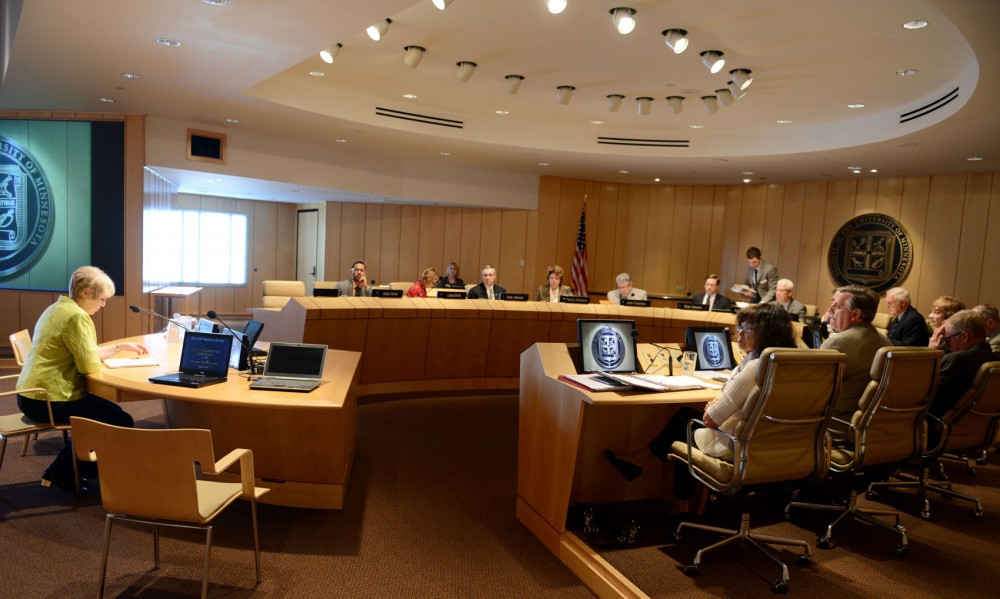In just one day’s time, the University of Minnesota’s Board of Regents ate a pancake breakfast with state legislators, attended a mock medical school graduation, took part in a statue unveiling party and joined business leaders and campus deans for dinner.
On the weeks that they have board meetings, the 12 regents sometimes devote more than 30 hours to their unpaid positions. They have the weighty job of overseeing the University’s five-campus system, mapping out the institution’s future and ensuring they’re upholding President Eric Kaler’s vision while still maintaining a critical eye.
“We’re eyes and ears for the president,” said Richard Beeson, chair of the board.
But aside from approving policies, a regent is always learning about the University’s inner workings and assessing their roles as key decision-makers — an important role some would like to make more attainable for applicants interested in serving.
A ‘rough process’
Becoming a regent isn’t a simple task. Some say it’s too political, forcing applicants to campaign — which may lead to some qualified individuals not having an equal chance at the position.
Sen. Terri Bonoff, DFL-Minnetonka, said she saw flaws in the regent election process last session and she wants to simplify the process.
“I was appalled by what our regent candidates had to do,” said Bonoff, who chairs the Senate Higher Education and Workforce Development committee.
In order to be successful, she said, candidates have to visit offices for each of Minnesota’s 201 legislators and campaign for support.
Bonoff said she wants to draft proposals to reform the process, but she won’t pursue the change this legislative session. Lawmakers in the House’s higher education committee didn’t see it as a priority this year, she said, and it would need their support.
Regent Linda Cohen, who won re-election last year, agreed with Bonoff’s concerns.
“It shouldn’t be quite as political as it is,” she said.
A regent is elected to represent each of the state’s eight Congressional districts, and four others represent the state at large. Each regent serves six-year terms, and one-third of the 12 seats are up for election every two years, according to Minnesota law.
The process is extensive and competitive. When Cohen first applied for her position in 2007, more than 140 people applied for four open seats.
She interviewed with the Regent Candidate Advisory Council, which advises the Legislature in the election by recommending two to four candidates. She then successfully sought formal approval from former Gov. Tim Pawlenty — a step in the process that no longer exists.
Legislators disputed the governor’s power in the election and pushed to eliminate it.
Now, the joint legislative committee comprised of various members from both chambers nominates one candidate for each of the open slots, and the full Legislature votes on the position.
Other public universities, like the University of Michigan and the University of Nebraska, have statewide or district elections for the board. And at some schools, like the University of California, the governor alone chooses regents.
They may seem simpler on the surface, but Cohen said those systems aren’t any less political.
Although it’s a “rough process,” Beeson said, it’s beneficial for regent candidates to spend time at the state Capitol because it helps them understand the role better.
A balancing act
Some of the board’s main objectives are to support and hold the president accountable — a task that can be tricky at times.
Regents need to share a vision with the president about the University’s future, said Brian Steeves, board executive director and corporate secretary. If the two can’t agree, the University could suffer, he said.
“It’s a delicate balance,” Steeves said.
Regents said there is a good dynamic between the two under Kaler’s presidency.
“A healthy relationship between the board and the president is essential for a healthy organization,” Kaler said. “It’s a really important role, and we work all the time to make sure they’re involved at the right level.”
Beeson meets with Kaler at least once a month to discuss any concerns regents may have.
“It’s like any organization or family; it’s about communication,” Beeson said.
A full-time job
Regent Laura Brod beamed with pride while touring the University’s Masonic Cancer Center last month.
Wearing a white doctor’s coat, she walked around the regent information session at the Academic Health Center where the board learned about the center and did rounds with physicians.
During the off-months when the board doesn’t meet, regents stay in the loop by meeting with University leaders and spending time on campus — attending lectures, Gophers games and other special events.
“With any volunteer job, there has to be a level of passion around it,” Beeson said.
While there isn’t an April board meeting, regents will attend a national conference where governing boards from institutions across the country will discuss trends and problems that higher education systems face.
Steeves said the board office has made an effort this year to include opportunities for regents to learn about different parts of the University.
When Beeson began his regency in 2009, he spent a large amount of time going to “hundreds” of events around the Twin Cities campus. Now, he said he attends fewer events because he has a better grasp of knowing about the school’s community.
He said he spends more time thinking about big-picture ideas and the University as a whole, which he said is a 24/7 job.
“I can’t turn the button off,” Beeson said. “The issues are still there.”
It’s a big job, Steeves said, but regents have a strong passion for the institution that drives them forward.
“Every single person who comes to the Board of Regents has an absolute love for the University,” he said.


